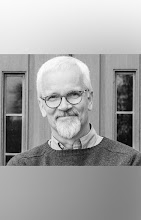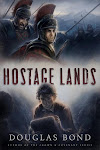DB It was a delight meeting you at the Redmond convention a
couple of weeks ago. I was intrigued hearing about Heroic Life Discipleship.
What is it?
MM It was great to meet you
as well! Heroic Life Discipleship (HLD) exists to provide resources for
building the next generation into leaders who understand and believe the gospel
and know and love Christ above all other things, who truly find their joy in
Him. The three main resources we offer are: 1) our flagship curriculum which is
designed mainly for churches/organizations to use in discipleship/outreach
context like sunday school or an after school club; 2) our Family Discipleship
Curriculum which is much the same content-wise as the church curriculum but
restructured to more simply facilitate parents leading family devotions; 3)
workshops and training to equip teachers and others to use the curriculum and
lead their ministries as effectively as possible.
DB We all have heroes, some
good ones and some not so good ones. Why did you choose the name? What does
“Heroic” mean in the title?
MM There’s sort of a double
meaning here. A hero is someone we look up to and want to be like. Jesus is the
greatest man who ever lived; we want to show Him to kids as the greatest hero,
the most majestic, sacrificial, humble, loving and lovable Savior and Lord. We
want Jesus to be precious to them and for them to become like Him. Paul talks
in Colossians 1:28 about presenting “everyone mature in Christ,” and that’s our
goal. Hence the name, Heroic Life Discipleship. We want to, in our small way,
cultivate the heroic life of Christ in others.
DB There are lots of
discipleship tools and programs out there. How is HLD unique?
MM As we worked through the
processes of planning and building our curriculum, there were a few key
strengths we wanted to incorporate:
Gospel based. We are passionate about
truth and holding to the authority of Scripture. God’s word is the source of
life and the way that we know Him. We don’t water down or change the gospel
(God didn’t write a children’s version of the Bible), although we do present it
in a way that’s easy for children to understand.
As part of this, a specific
strength HLD has is its focus on application. We’re not just teaching the
gospel, but walking kids through understanding it and applying it to their
lives - answering the “so what” questions.
Not focused on
entertainment.
It seems that many programs out there are designed just to give kids a fun time.
There’s nothing wrong with having fun, but that can’t be the goal. Like I just
mentioned, our goal is to effectively communicate truth. In doing that, we
structure the curriculum so it’s engaging and fun, but that’s not the
focus. The structure and way it engages children are tools supporting the
goal of the kids understanding the gospel.
One of the primary ways we
do this is through question- and discussion-based teaching. Rather than a
teacher just “talking at” children, they lead a discussion with them, asking
open-ended questions to help the students think through things and come to
truthful conclusions themselves.
Simple and intuitive. This is demonstrated in
two primary ways::
First, in the content and
spiritual impact of the curriculum. We want a tool that strikes a healthy
balance between 1) being too simple, just a script to pick up and read, and 2)
needing a ton of time to study and prepare a lesson and put together teaching
notes. One of the core ideas we operate on is that a teacher must personally
own truth to effectively give it to others (1 Cor. 9:27). So we don’t want
people just reading a script. But we also know that people have busy lives and
can’t put hours into studying and preparing a lesson, figuring out what the
focus should be, etc. We’ve attempted, successfully I think, to strike a
balance where we don’t give the teacher a script, but it’s easy to review the
outlines, get familiar with the content and direction, and lead a meaningful
discussion with children.
Second, the layout,
usability, and functionality of the curriculum. It’s simple in the schedule and
flow of each lesson. The lesson outlines are intuitive, and it’s easy to know
what to do without needing to put time into figuring it out.
Based on the feedback we’ve
received from churches and other groups who have used the Heroic Life
Discipleship curriculum, all these different goals have been effectively
achieved.
DB Can you give us an
example of what it looks like?
MM Sure. Our curriculum is
built around three main components:
First, our Bible Story
Guide, which is a discussion of a Bible story (the curriculum progresses
chronologically through Scripture). It guides children in making observations
about the story, understanding its meaning, and serves as an introduction to
ideas discussed later on in the lesson. Bible Story Guides can be very
effective in small or large groups with a wide age-range of children.
Second, the Application
Guide. This is where the rubber meets the road in our discipleship model.
The Application Guide builds off of the Bible Story Guide, discusses different
Scripture passages, emphasizes knowing and loving God, and leads to practical,
real-life steps of obedience for students to take. Application Guides are
designed to be used in a small group setting, allowing for more
personalized discipleship for the students.
Third, we have our Mighty
Men and Intercession lessons. The Mighty Men lessons are short biographies of
Christian heroes like Hudson Taylor or John Wycliffe. This gives the kids a
picture of someone who actually lived out what they’re learning in the Bible
Story Guide and Application Guide. The Intercession lessons are studies of
different countries around the world. We discuss an overview of the country -
culture, geography, government - but then focus in on the persecuted church and
unreached people groups. This broadens kid’s perspectives beyond their own
little world to see that they’ve got suffering brothers and sisters and that
there are people who have never heard of Jesus.
DB Why did you develop HLD?
What got you thinking about developing such a ministry tool?
MM I was actually part of a
team in the summer of 2012 that was asked by the leadership in our church to
create a new children’s program. After evaluating several different curricula
out there, we decided that there wasn’t anything that was a great fit for what
we needed… hence the fateful decision to write our own. After working on it for
a few years, and teaching through the entire curriculum we decided that since
we’re already putting so much effort into it, we might as well provide it as a
resource for other churches and families to use as well.
DB How does a church or
other ministry begin using HLD? Is it easily adapted to large or small groups,
or is it best one-on-one?
MM We have all kinds
of different groups using HLD. Sunday schools/church programs, after school
clubs, inner-city kids outreaches, individual families, an orphanage overseas,
etc. So it’s pretty flexible… It works great in a lot of different contexts and
is very adaptable. We also have our Family Discipleship version which is a
simplified version of the same content specifically designed for family
devotions (we’re hoping to launch this curriculum in August of this year).
If a church was interested
in using HLD, we’d love to be in touch with them to help with a smooth
implementation. But essentially, they’d just go on our website and order the
curriculum they need. We recommend that they then take our online Leader
Training which is a 10-hour video course (in 30 minute sessions) that’s a very
thorough introduction to HLD and training, how to use each element of the
curriculum, and how to lead an HLD program. After a children’s ministry leader
or team has taken the course, we can provide additional coaching/workshops if
desired to further equip the leaders/teachers to effectively disciple their
students.
We realize it’s a big step
to start using a new sunday school curriculum, so we’re available to help out
in whatever way is most helpful for folks.
DB Are there any other
features of HLD that you would like to tell us about?
I’m really excited about
our Family Discipleship curriculum that’s coming out soon. This will be
basically the same content as our children’s program curriculum but simplified
and shortened to make it ideal for parents to use in leading family devotions.
It’ll be completely digital, so no messing with papers unless you want to print
it. You’ll sign up and get an email each week with five lessons in it - a Bible
story, two short application discussions, a Mighty Men or Intercession lesson,
and a review lesson.
We’re hoping this will be a
great resource for parents who have struggled to know how to disciple their
children or who don’t have much time to put into preparation/planning for it.
DB Who has endorsed HLD
program and what did they say about it?
MM Our ministry is still
pretty young, so we don’t have a lot of “big name” endorsements. But we’ve
gotten great endorsements from the folks who’ve used us and looked at our
material so far. Here’s a few:
Josh Beaudin, Mobilizer
with New Tribes Missions:
For several years I have
been asking the Lord to raise up a generation of young people whose hearts are
ablaze with His passions and whose lives are engaged in His eternal purposes!
If the ministry vision of Heroic Life Discipleship were to be implemented across
our nation (or any nation for that matter), I believe we would see such a
generation raised up. I whole-heartedly recommend this ministry!
Heroic Life is simple, easy
to use, easy to understand, and timeless and powerful because it is laser
focused on the Word of God and the Gospel. No matter what classroom a child
walks into, I know they are studying the Word of God and hearing the Gospel every
week. The Gospel is the center of both the children's curriculum and the
teacher training workshops.
DB How can folks learn more
about HLD?
MM Check out our website at
www.heroiclifediscipleship.com. From there, folks can
learn more about the Heroic Life Discipleship team, our curriculum, view
samples, and buy it. We also have a blog where we’re posting content weekly
that’ll be encouraging both for ministry leaders and for every-day Christian life.
You can also connect with us on Facebook and Instagram.
Follow our progress on the LUTHER 500 TOUR beginning June 15 @bondbooks on Instagram and facebook

































